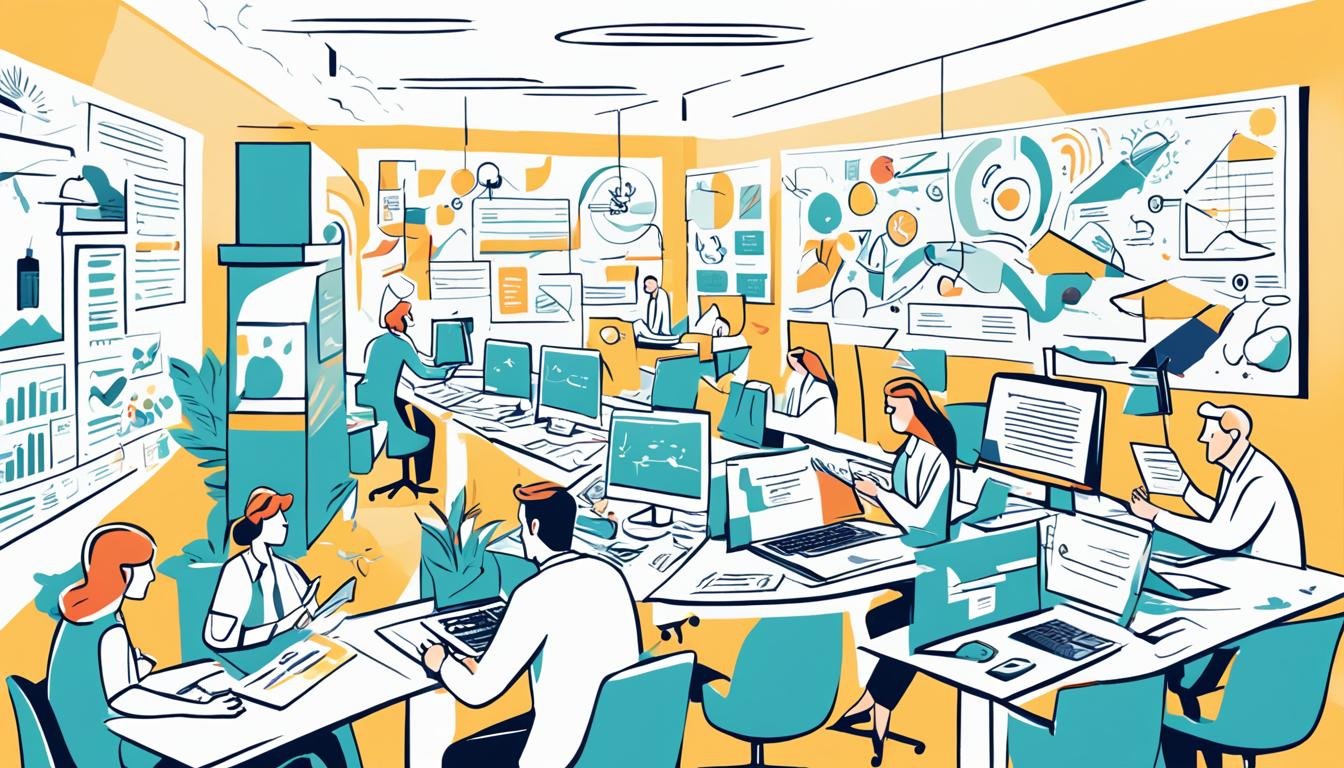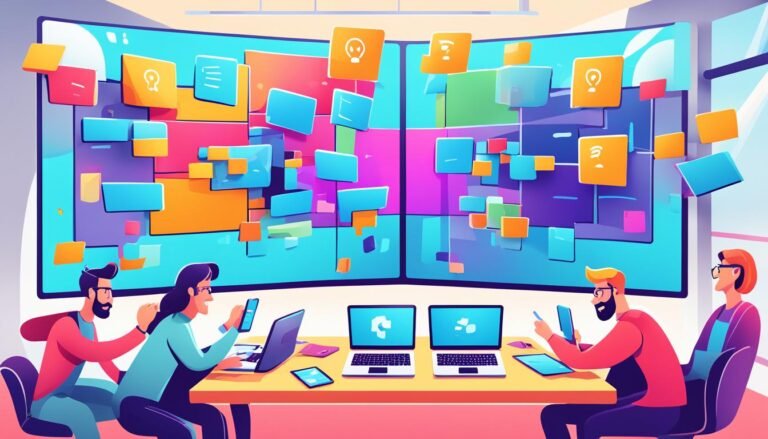The Impact of Remote Work on Business Innovation
Remote work is changing how businesses work, offering more flexibility and saving money. Yet, it raises questions about how it affects innovation. Does working remotely help or hurt creative thinking? Together, let’s look into how remote work and innovation are connected. We want to see the real influence it has on businesses.
Key Takeaways
- Remote work has become prevalent in the corporate world, prompting questions about its impact on innovation.
- Research suggests that in-person collaboration plays a key role in driving innovation through face-to-face interactions and spontaneous discussions.
- Advancements in technology have improved remote collaboration, bridging the gap between in-person and remote teams.
- Cognitive biases can influence perceptions of remote work, hindering organizations from recognizing its benefits for innovation.
- Implementing effective strategies like virtual brainstorming and leveraging AI-driven tools can foster innovation in remote work environments.
The Role of In-Person Collaboration in Innovation
In-person teamwork significantly boosts innovation. Being together, people can share ideas, interact directly, and have quick talks that spark new ideas. For example, Larry Page improved Google’s ad algorithm through face-to-face team work.
Contrastingly, working from home might hinder these interactions. When not together in an office, sharing ideas becomes harder. Remote work misses the ease of talking in person and reading subtle body language. Missing out on random chats and casual brainstorming can lower a team’s creativity levels.
Yet, remote work isn’t a complete barrier to team innovation and creativity. Thanks to technology, we can use virtual tools to connect far-apart colleagues. Such tools allow for video calls, shared documents, and solving problems together remotely.
“While remote work challenges face-to-face collaboration and innovations, it opens doors to more diverse teams and new solutions.”
To help remote teams be more creative, organizations are using special methods. One is virtual brainstorming, where each person shares ideas online, then they come together to discuss and improve them. This method encourages diverse ideas and thinking ways.
The growth of remote working has also prompted the use of AI tools. These tools can help inspire creative ideas. With AI help, organizations can make the most out of remote teams by pairing human creativity with machine insights.
Now, let’s see how meeting in person boosts innovation by looking at the table below:
| In-Person Collaboration | Remote Work |
|---|---|
| Promotes spontaneous idea generation | May hinder spontaneous discussions |
| Facilitates immediate feedback and collaboration | Relies on virtual communication and delayed responses |
| Encourages nonverbal communication and body language cues | Nonverbal communication may be limited to video calls |
| Fosters a sense of team camaraderie and shared purpose | Team cohesion may be harder to develop and maintain |
As the table shows, working together in person has special benefits. It includes better idea generation, instant feedback, clear understanding through body language, and stronger team connections. Alternatively, remote work allows for bringing together diverse talents and creating new ways of solving problems.
In the next section, we will explore the evolution of remote collaboration and how it has shaped the landscape of innovation.
The Evolution of Remote Collaboration
The way people collaborate online has changed a lot thanks to technology advancements. Now, teams can easily work together from different places. With the help of video calls, shared documents, and group tools, being far apart is not a problem. This change has boosted how much work gets done, the new ideas that are shared, and how fast they’re brought to life.
At first, it seemed like teams not working in the same place were less creative. But as tech and tools improved, that changed. Remote teams now come up with as many cool ideas as teams that are together in one place.
The picture above shows how remote teams can create and share together, even though they’re miles apart. It looks at how smoothly these teams work, bouncing ideas and working on them, all without being in the same room.
Thanks to the latest tech, working together from a distance doesn’t hold teams back anymore. Now, they can build strong bonds, solve problems in smart ways, and come up with ideas that change the game, just like when they’re together.
Innovation Deficit Comparison: Remote Teams vs. In-Person Teams
| Remote Teams | In-Person Teams | |
|---|---|---|
| Overall Innovation | Gradually decreasing deficit | Established innovation practices |
| Ideation | Enhanced through virtual brainstorming | In-person interactions |
| Collaboration | Facilitated by collaborative platforms | Spontaneous discussions in the office |
| Communication | Efficient through video conferencing | Face-to-face interactions |
This neat table compares how good remote teams are at coming up with new things compared to teams that work together in an office. It shows us that remote teams have gotten a lot better. They’ve almost caught up to in-person teams. Yet, each way of working has its perks.
Today, working together online can push businesses to find new ways to solve problems and come up with fresh ideas. As technology keeps advancing, remote teams will only get better at being creative, finding solutions, and contributing to big changes.
Cognitive Biases and Remote Work Perception
Cognitive biases deeply influence how we see remote work’s effect on coming up with new ideas. Two key biases are confirmation and status quo bias.
Confirmation bias means we look for info that backs up what we already think. We ignore info that goes against our views. In remote work, some people might only see studies that say it stops new ideas. They might miss out on new research showing remote tools help with creativity.
Status quo bias is about liking things to stay the same. In terms of remote work, it makes some people not want to try new ways of working. They might prefer the old way of being with their team in person. And they might doubt if working remotely really helps making new things.
Getting past these biases is key for companies wanting to see the good in remote work and use creative ways to work. It means they need to doubt what they think, look at new facts, and see other points of view. This opens up chances for remote work to bring in fresh ideas, like brainstorming online.
“To overcome cognitive biases, organizations must actively challenge their assumptions and seek out diverse perspectives. Embracing remote work and the opportunities it presents for innovation requires a mindset of continuous learning and adaptation.” – Jane Roberts, Chief Innovation Officer at InnovateCorp
By tackling and dealing with these biases, companies can get a more fair and knowledgeable view of what remote work does for creative thinking. This helps them put remote work in a smart and powerful way, boosting how they work together and come up with new things.
The Role of Cognitive Biases in Remote Work Perception
Cognitive biases do a lot to shape how we think about remote work’s effect on new ideas. Understanding these biases helps companies deal with their impact. This way, they can make the best of remote working.
| Cognitive Bias | Description | Implications for Remote Work Perception |
|---|---|---|
| Confirmation Bias | The tendency to seek out information that supports existing beliefs while dismissing contradictory evidence. | May lead to a narrow focus on studies or anecdotes that reinforce the belief that remote work hampers innovation, disregarding new research and advancements in remote collaboration. |
| Status Quo Bias | The preference for maintaining the current state of affairs and resistance towards change. | May create resistance to adopting remote work models and emerging technologies that support remote collaboration, stemming from a preference for traditional, in-person teamwork. |
Table: Cognitive Biases and Their Implications for Remote Work Perception
Fostering Innovation in Remote Work Environments
Remote work has changed how companies work, giving them flexibility to grow. To make remote work really work, companies need to push for new ideas. They must encourage thinking outside the box through things like online group sessions and smart tech.
Virtual Brainstorming for Enhanced Idea Generation
Virtual brainstorming is perfect for teams that work apart, letting them share ideas anytime. They use cool tools like Google Forms and MURAL to connect and discuss. This method welcomes all kinds of ideas and thinking, leading to unique and helpful results.
“Virtual brainstorming allows remote teams to leverage their collective knowledge and creativity, fostering a collaborative environment where unique ideas can flourish.” – Jane Smith, Innovation Manager
The Power of AI-Driven Strategies
AI can really boost how teams come up with ideas in remote settings. It looks at tons of information, finds trends, and helps spot new ideas. This mix of human creativity and AI power drives teams to find amazing new solutions.
“AI-driven strategies have proven to be game-changers in remote work environments, enabling us to explore uncharted territories and disrupt traditional industry norms.” – David Johnson, CEO

The Future of Remote Work Innovation
The future of remote work looks very bright for new ideas. Companies going big on virtual brainstorming and AI are set to lead. They’re creating a culture of innovation and using tech in smart ways. This will bring big changes, more work done, and huge success.
The Importance of Infrastructure in Remote Work Innovation
Good infrastructure, especially broadband, is key in making remote work better. Teams with great broadband see better innovation. This shows how important it is to have good internet for people to work together from far away. As tech gets better, it’s more crucial for companies to improve their infrastructure to help their employees work remotely and come up with new ideas.
In today’s world, a solid infrastructure for remote work is a must for companies to do well. Teams working from different places rely a lot on good internet to talk, work together, and get what they need. Strong and fast internet means smooth online meetings, working together in real-time, and sharing files fast. But, without good infrastructure, remote workers could have problems connecting, stopping them from being part of the innovation process.
Accelerating Innovation with Reliable Connectivity
A top research group found a strong link between broadband and coming up with new ideas. Companies with fast, reliable internet said they had more creative problem-solving and innovation. This is why it’s key to have a stable, high-quality network to encourage new ideas in remote workers.
Having a good infrastructure lets remote teams use technology to work better and create new things. Things like online brainstorming, creative workshops, and teamwork tools help people work on and improve ideas together, even if they’re far apart. This way, not being in the same place lets more varied thoughts and talents join in, leading to more innovative and unique results.
The quality of infrastructure in remote work environments directly affects innovation outcomes. Teams with reliable broadband connectivity experience improved creativity and problem-solving, leading to breakthrough innovations.
The Need for Infrastructure Investment
In the future, where more people work remotely, it’s vital to invest in infrastructure to get more innovative work. This means better networks, making sure everyone can get online in remote spots, and strong cybersecurity. These steps build a foundation for successful remote work.
Also, it’s important for companies to work with internet providers, government leaders, and local areas to narrow the digital gap, so everyone has the same access to fast internet. This makes remote teams more diverse and lets people from all over join in creating new things.
The Role of Infrastructure in Remote Work Sustainability
Putting money in remote work infrastructure supports creating new things and helps save the planet. Remote work cuts back on the need to travel to work, which means less traffic and less pollution. It’s a way for companies to help the environment and improve employees’ lives too.
For companies to really benefit from remote work and innovation, they need a strong and efficient infrastructure. This involves focusing on broadband and building up network capabilities. By doing this, businesses make sure their remote teams have what they need to work together well and create exciting new ideas.
Overcoming Challenges and Embracing Remote Work Innovation
Remote work offers new ways to drive innovation. But, organizations face challenges when starting and managing it. Yet, by involving diverse views and tackling biases, a company can foster innovation. Also, being open to new tech and methods allows the advantages of remote work to shine and helps fight challenges.
Proactively Seeking Diverse Perspectives
One big challenge with remote work is missing face-to-face talk. This can limit seeing different viewpoints. To fix this, firms can push for inclusivity and ensure everyone gets a say. They might encourage joining in virtual meetings, make teams with various skills, and build a culture that supports sharing different views.
Addressing Biases and Preconceived Notions
There’s a common bias that remote teams aren’t as effective as in-person ones. By recognizing and dealing with these beliefs, companies can see the value of remote work. Making decisions based on data and questioning beliefs with logic can help change these views. This creates a workplace that is open to remote work innovations.
“It is not the strongest or the most intelligent who will survive, but those who can best manage change.”
– Charles Darwin
Embracing New Methodologies and Technologies
Remote work innovation involves trying new ways and tools to share, communicate, and create together. Tools like virtual brainstorming and AI for strategy can make remote teamwork stronger. Using these supports can set a company ahead of its competitors.
Unlocking the Innovative Potential with an Evidence-Based Approach
An evidence-based view to remote work means using data and tests to make smart choices. By looking at productivity and employee happiness stats, companies can improve their remote work setup. This boosts innovation by making the most of remote work’s potential.
Embracing remote work challenges needs a forward-thinking stance, a readiness for change, and a reliance on solid data for choices. Seeking diverse perspectives, combating biases, and using new tech fosters innovation in business operations.
The Future of Remote Work Innovation
The way we work remotely is changing. Companies are mixing in-office work with working from home, using both in new ways. This mix boosts ideas and makes sure everyone can take part.
Creating Hybrid Work Models
Hybrid work combines the best of both worlds. It lets people connect on the spot in the office. At the same time, working from home adds freedom and access to more types of skills.
“Hybrid work models harness the advantages of in-person interaction while leveraging the flexibility and inclusivity of remote work.”
These models let companies create the right balance for their teams. They make a workforce that can change with the times and get things done in new ways.
Integrating AI-Driven Tools and Technologies
AI is changing how we work from afar by helping with ideas and data. It makes innovation quicker and more detailed by using a lot of information.
With AI, teams can see trends and make choices based on real data. AI tools like virtual helpers and bots can also make work easier, leaving more time for important tasks.
The Evolving Landscape of Remote Work
Remote work is getting better because of new tech and ways of working. AI is becoming crucial here, improving how we do things and offering fresh chances for creativity and solving problems.
Conclusion
Remote work has changed how business works. It has made people rethink working together in person. This new way of working has led to more innovative ways for companies to work.
Early on, some thought working remotely had its downsides. But with new technology and clever strategies, the gap between working online and together has lessened.
To make the most of remote work, companies should deal with common thinking mistakes. These include only seeing what confirms what we think and sticking to how things have always been done. Overcoming these ideas is key to seeing how remote work can truly boost creativity in business.
The future of working from anywhere looks promising. Mixed work models, using both online and in-person meetings, can bring out the best in each. Adding AI to the mix can take creativity to new heights. This all opens the door to more innovative teamwork.
Companies that make the most of remote work can do really well. By working together from afar, they can find new ways to be creative. This can help them stand out in a tough market.








